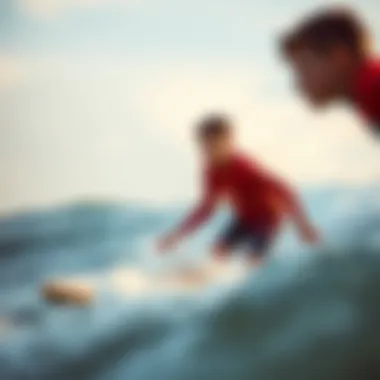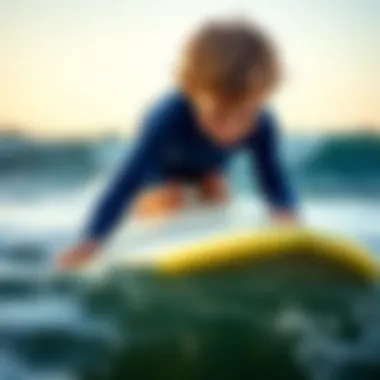Crafting the Perfect Family Surfing Adventure


Intro
Planning a family surf trip is akin to finding a needle in a haystack if you're not equipped with the right information. From selecting the right spot to ensuring everyone, from the littlest grom to the most seasoned rider, has a memorable time, there’s a lot to untangle. It’s not just about catching waves; it’s about weaving together a tapestry of shared experiences and thrilling adventures. With surf culture becoming ever more popular, getting this planning right can ensure your family trip is not only enjoyable but educational as well.
Expert Insights
When it comes to surfing, local knowledge speaks volumes. Understanding the landscape of surf destinations is pivotal. Families should look for places like Huntington Beach in California, known for its consistency and variety in wave types, making it an ideal spot for surfers of all levels. This beach also boasts numerous surf schools that can accommodate inexperienced surfers, giving everyone a chance to ride the waves safely.
Latest Trends in Watersports
Interestingly, surfing has seen a shift in trends, particularly in equipment and training methodologies. Many surf schools now utilize virtual reality to help beginners grasp basic concepts before ever stepping foot in the ocean. This intriguing approach not only speeds up the learning process but also boosts confidence.
Furthermore, eco-friendly materials are gaining a foothold in surfboard manufacturing, with companies increasingly offering boards made from sustainable materials. This is not only trending but promotes a higher awareness of preserving our oceans, which is a crucial topic for families to discuss during their trip.
w "The ocean is a shared resource; protecting it is our duty as surfers and custodians of the environment."
Safety Protocols and Best Practices
Safety is paramount, especially when frolicking in the surf. Here are some basic protocols families should consider:
- Assess Surf Conditions: Knowledge of tides, currents, and wave heights can spell the difference between a fun day and a potential disaster. Always check local surf reports.
- Buddy System: Swimming or surfing with a partner is essential for safety. This is especially true for kids who might tire more quickly.
- Proper Gear Usage: Depending on skill level, the use of rash guards, helmets, or even leashes can prevent injuries.
Equipment Recommendations
Choosing the right equipment can greatly influence the enjoyment of your family surf trip. Here's what families should consider:
Must-Have Gear for Beginners
When just starting out, you don't need to break the bank. Here are some essentials:
- Soft-top Surfboards: These are forgiving for beginners. Brands like Wavestorm produce boards that are both safe and stable for first-timers.
- Leash: A sturdy leash prevents the board from getting lost after a wipeout.
- Rash Guards: Protects from sunburn and board rash.
Advanced Equipment for Pros
For families with more experienced surfers, investing in quality gear can enhance performance:
- Performance Shortboards: High-quality brands like Firewire offer lightweight, durable options that are ideal for advanced maneuvers.
- Wetsuits: Depending on the water temperature, a good wetsuit can make all the difference. Brands like O'Neill provide reliable products that keep surfers warm.
Choosing the Right Destination
Choosing the right destination is crucial when planning a family surf trip. Not all beaches are created equal; some offer gentle waves perfect for beginners, while others challenge even the pros. Picking the right spot can make or break the experience for every family member.
When considering a location, think about accessibility and available amenities. Families require not just surf-friendly waters, but also supportive infrastructure—easy access to food, restrooms, and safety services. A thoughtful choice can save you from stressful moments and allow everyone to enjoy their time on the water.
Popular Surf Spots for Families
Assessing Skill Levels
Taking stock of each family member’s skill level is key in finding suitable locations. If you're traveling with little ones just learning to balance, choosing a beach known for its smaller, more forgiving waves will help foster confidence. On the flip side, if some adults are more experienced, they might appreciate a spot that offers a bit more challenge.
A well-chosen surf spot accounts for these differences and allows families to enjoy varied experiences without frustration. For instance, beaches like La Graviere in France provide both mellow surf for beginners and more powerful waves nearby for the confident ones. This combination can satisfy every rider’s appetite, and the diverse options are beneficial for creating a group experience that caters to individual needs.
Family-Friendly Amenities
Family-friendly amenities can significantly enhance a surf trip. Toilets, shower facilities, and eateries nearby can turn a surfing venture from a chore into an enjoyable getaway. Some spots even have lifeguards on duty, which adds an extra layer of security when surfing with kids.
For example, beaches like Waikiki in Hawaii have ample parking, picnic areas, and surf schools offering rentals and lessons right at the shore. This means you don't have to haul your gear too far and can take breaks when needed, allowing for a leisurely, relaxed approach to surfing.
Duration of Trip Considerations
The duration of your trip has a glaring impact on the destination. A long trip pushes the envelope for a more distant or exotic location, while shorter breaks might best suit nearby beaches. Generally, longer vacations allow families to expand their horizons, explore various activities, and even experience the local culture.
Planning multi-day trips can also open up opportunities to experience different surf conditions, making it easier to find the best daily waves. For example, a week in Southern California can let you surf from Malibu to San Diego, offering vastly different breaks in just a few hours of driving.
Understanding Local Surf Culture
Exploring the local surf culture can deeply enrich the experience for a family. It's not just about catching waves; it's about immersing in an environment that often values community and sustainability.
Engagement with Local Communities


Engaging with local surf communities fosters a connection and opens doors to authentic experiences. It can also lead to lasting friendships that enrich your trip. Local communities often have activities like surf clean-ups or beach barbecues. Participating in these can provide deeper insights into the area’s culture and values.
Local surf shops, like those in Nosara, Costa Rica, frequently organize community events that travelers can join, providing opportunities to learn about the culture while building connections.
Learning Opportunities
Every surf trip is a chance to learn something new. Whether it's about local techniques or unique ocean conditions, soaking in knowledge is a rewarding part of the adventure. The surfing community is often quite welcoming, offering insights that you might not find in a guidebook.
In places such as Puerto Escondido, surf schools sometimes provide insights into local history and ecology, making education a part of the fun. Families can learn about wave patterns or marine life, enhancing their respect for the environment.
Environmental Awareness
Awareness of local environmental issues is vital. Many coastal areas face challenges, such as pollution and habitat loss. Choosing destinations that prioritize environmental health can enhance family bonding experiences while developing a shared ethos towards ocean conservation.
For instance, beaches that promote eco-friendly surf practices or engage in conservation efforts can often inspire families to adopt similar habits at home. Engaging with these initiatives means you leave a place in better shape than you found it, creating a positive impact that resonates with the surfing spirit.
Surf Conditions and Safety
When it comes to planning a family surfing trip, understanding surf conditions and safety is paramount. Not only does it ensure everyone’s enjoyment, but it significantly reduces potential risks that could arise in the water. Assessing various surf conditions helps families make informed choices about where and when to surf, potentially making the difference between a relaxing day at the beach and a frantic scramble for safety. Safety should be at the forefront of any family-oriented activity, especially one that involves navigating waves and currents.
Evaluating Surf Conditions
Tide and Weather Patterns
The tide and weather patterns play an essential role in determining the best times to hit the waves. Checking the tides can help surfers choose when the water is more suitable for their skill level. Typically, the slack tide—when the water is neither rising nor falling—is favorable for beginners, as it offers gentler conditions. One of the key characteristics of tide patterns is their predictability; seasoned surfers rely on tide charts to plan their sessions.
However, a unique aspect to consider is that weather conditions can change rapidly. For instance, a sunny morning can quickly turn into a stormy afternoon, drastically altering wave conditions. Hence, checking both local weather forecasts and tide schedules is vital for a safe surfing experience.
Identifying Wave Types
Knowing how to identify wave types directly impacts one’s enjoyment and safety while surfing. Waves can be categorized into various types, such as beach breaks, reef breaks, and point breaks. Beach breaks are generally more forgiving for beginner surfers, as they tend to produce softer waves. On the other hand, reef breaks can be more challenging and require advanced skills.
The ability to recognize the characteristics of different waves allows families to choose surf spots that align with their skill levels. This knowledge fosters confidence in less experienced surfers and reduces the likelihood of accidents. Families should look for spots with consistent, manageable waves to ensure safety and enjoyment for all.
Understanding Rip Currents
Understanding rip currents is vital for any beach outing. These swift, narrow channels of water flow away from the shore and can be quite dangerous, especially for inexperienced surfers and children. Recognizing the signs of rip currents, such as choppy water, foam, and a channel that looks different from surrounding waves, can prevent accidents.
The benefit of this knowledge is twofold: firstly, it prepares families to navigate safely during their surfing adventures, and secondly, it empowers them to stay calm in potential emergencies. Surfing locations often provide visibility markers for rip currents, creating an added safety buffer for visitors.
Safety Precautions for Families
Adult Supervision Techniques
When surfing with family, particularly with younger children, adult supervision techniques are crucial. Adults must remain vigilant, keeping an eye on the younger surfers to ensure they are safe and within an appropriate range. Utilizing proper buddy systems can improve both safety and enjoyment, allowing families to engage directly in each other's experiences and support.
For example, designating one adult to supervise a specific group at all times ensures constant monitoring. This practice allows adults to be more in tune with the comfort levels and skill progression of their children, creating a safer atmosphere overall. However, the unique feature of this technique is that it not only fosters safety but also bolsters family bonding through shared experiences in the water.
Using Leashes and Safety Gear
Another fundamental aspect of surfing safety is the use of leashes and appropriate safety gear. A leash attaches the surfboard to the surfer, minimizing the risks of losing it during a fall, which can lead to injury for both the surfer and others in the vicinity. This simple piece of equipment becomes essential, especially for families surfing together, as it prevents separation from the board in tumultuous waters.
Additionally, wearing safety gear like helmets and life jackets can enhance safety measures, particularly for beginners or children. The unique feature here lies in being proactive—using safety gear not only prepares participants for accidents but also encourages a culture of safety that families can share.
Emergency Procedures
Finally, having well-defined emergency procedures in place is necessary for families planning to surf. Knowing how to respond to an emergency, whether it’s a serious injury, a surfer in distress, or sudden environmental changes, can be critical. Setting aside time to discuss these procedures can benefit the entire family. For instance, familiarizing everyone with nearby lifeguard stations and emergency services enhances preparedness.
A valuable characteristic of having a clear emergency plan is that it instills confidence, allowing families to focus on the fun aspect of surfing without undue worry. A unique advantage here is that this level of preparedness can also help families to build resilience and adaptability, empowering them to navigate unforeseen circumstances with ease.
Safety is not just an option; it’s a necessity! Always prioritize surf safety, understanding conditions, and maintaining open lines of communication with your family.
These considerations about surf conditions and safety can transform a simple family outing into a memorable experience, one where every member feels empowered and knows their abilities and limits.
Equipment Essentials
When you're gearing up for a family surf trip, understanding the Equipment Essentials is crucial. The right tools can make or break the experience. Your choice of surfboards, safety gear, and accessories directly impacts everyone's safety and enjoyment. Preparing well means every family member can fully engage, no matter their level of experience.
Selecting the Right Surfboards


Choosing Based on Skill Levels
Choosing the right surfboard based on skill levels is fundamental. For instance, beginners often fare better on wider, more stable boards like soft tops, which provide a large surface area for balancing. As skills improve, switching to narrower and more agile boards can enhance performance. This gradual transition not only builds confidence but also aligns with growing abilities.
A significant characteristic of this approach is that it tailors to the individuals in the family. Kids, for example, will benefit from boards designed specifically for their lighter weight and sizes. On the other hand, adults looking for an adrenaline kick might opt for performance boards as they gain experience. This careful selection process not only maximizes enjoyment but also reduces frustration.
Board Size Recommendations
When it comes to board size recommendations, it’s essential to balance between stability and maneuverability. Generally, a longer board offers more stability, which is beneficial for beginners and younger surfers. Shorter boards, however, provide more agility as one progresses in skill. A unique feature of sizing is using a height-to-board ratio—usually, a board length that is around 1-2 feet shorter than one’s height is a good starting point for most.
One advantage of tailored sizing is safety; boards that are the appropriate size can mitigate potential mishaps like falls and collisions. However, using a board that's too small for an inexperienced surfer can lead to unnecessary challenges in learning, which is why sizing should never be overlooked.
Renting vs. Buying
The question of renting versus buying surfboards often arises, particularly among families who may be newcomers to the sport. Renting is beneficial for those who aren't sure how often they will surf or for those who want to explore different types of boards without a long-term commitment. Rental shops typically offer a variety of boards tailored to different skill levels and preferences.
On the flip side, buying offers a personal touch. Owning a board means it can be customized to fit your family’s needs. For instance, a family might invest in one board that everyone can use, promoting shared experiences. The downside, however, is the initial cost and maintenance that comes with ownership, making renting often the more immediate, practical solution for families just diving into the surf lifestyle.
Additional Gear to Consider
Wetsuits and Rash Guards
Wetsuits and rash guards play a vital role in ensuring comfort during surfing, especially in varying water temperatures. Wetsuits provide insulation against cold while allowing for fluid movement. Rash guards offer protection from the sun and potential irritation from board friction. A helpful tip is ensuring these gears fit snugly for maximum thermal efficiency; loose fittings can lead to increased water flow and subsequent cooling.
The unique feature of these items is versatility; they come in different thicknesses and styles. However, a downside can be the complexity in choosing the right gear for different weather conditions—families may find themselves needing multiple suits depending on locale and season.
Surf Accessories
When contemplating surf accessories, one cannot overlook items like surf wax, fins, and leashes. Each has its strong points; for instance, surf wax enhances grip, while fins give control and maneuverability. Leashes, meanwhile, are crucial for safety, keeping the board close after a wipeout. Families need to form a checklist of methods to keep their surfing kit complete.
The uniqueness lies in their specific functions, elevating your surfing game when used correctly. Each item has its particular use but can also be unwieldy when not well organized or if a crucial piece is left behind at home. Therefore, keeping an eye on gear status will prevent disruptions during family surf days.
Safety Equipment
Safety equipment should never be an afterthought on a surf trip. Basic items such as first aid kits, flotation devices, and signal whistles can come in handy. The contribution of safety gear cannot be overstated; it provides peace of mind, allowing families to focus on enjoying the moment while knowing they are prepared for emergencies.
The distinguishing feature of safety equipment is its preventive nature—it shields families from unforeseen incidents. However, to an inexperienced eye, the range and necessity of certain items may seem overwhelming, making it vital to assess personal needs closely and avoid packing excessive items that might not be used.
Safety First: Always prioritize safety gear; it can turn a challenging day into a manageable experience.
Lessons and Instruction
Mastering the art of surfing isn’t just about riding waves; it’s also about fostering bonds within the family. Engaging in lessons and instruction sets a foundation for the entire trip. With varying skill levels and ages, learning from a professional becomes crucial. This document aims to break down the various aspects of lessons and instruction, ensuring that every family member has the opportunity to enjoy and learn the sport safely.
Finding Suitable Surf Schools
Evaluating Instructor Qualifications
When looking for a surf school, the qualifications of the instructor can’t be overlooked. A qualified instructor typically holds certifications from reputable institutions like the International Surfing Association. These certifications signify a formal understanding of surf techniques, safety protocols, and teaching methodologies, ensuring that your family receives quality instruction. A good instructor will not only help with technique but can also communicate effectively with children and adults alike. Without a proper assessment of these qualifications, families might find themselves in potentially hazardous learning environments or simply miss out on effective progression in their surfing skills. A school that has instructors with proven credentials is a wise choice.
Private vs. Group Lessons
Private lessons provide one-on-one attention, which can lead to quicker skill acquisition for beginners or those looking to refine their technique. These lessons can align perfectly with individual learning paces, ensuring that no one feels rushed or left behind. However, they often come at a premium cost. On the other hand, group lessons offer an excellent way for families to bond and encourage each other in a social setting, possibly creating lifelong memories. That said, the challenge with group lessons may arise when there’s a significant range of skill levels, which can impact overall learning speed and safety. Ultimately, the decision between private and group lessons hinges on individual needs, budget considerations, and the family dynamic.
Customizing Lessons for Kids
Customizing lessons specifically for children can significantly enhance their learning experience. Kids often benefit from activities tailored to their interests and energy levels. For example, instructors who include fun games related to paddling or balancing can retain a child's enthusiasm while teaching them essential skills. This personalization helps maintain engagement, enabling young learners to embrace surfing as a fun and rewarding activity rather than a chore. A downside could be finding a surf school that offers this tailored approach, as not all instructors may have the experience or understanding of child psychology necessary for effective teaching.
Surfing Techniques for Families
Basics of Paddling and Pop-Ups
In surfing, mastering paddling and pop-ups is crucial for any beginner. These foundational techniques dictate how well one can position themselves on the surfboard and engage with the wave. It’s all about timing and muscle memory, which means consistent practice is key. Families working together on these basics can fast-track their skills, making their time in the water more enjoyable. Engaging in friendly competition during practice can motivate family members to learn from each other, making the learning experience fun. However, without proper guidance, bad habits can form quickly, making it vital to seek out an instructor for these initial learning phases.
Tandem Surfing Tips
Tandem surfing, where two people ride the same board, can be a thrilling experience for families looking to create shared memories. It requires trust and communication between partners. Tips for successful tandem surfing include maintaining balance, coordinating movements, and communicating effectively in the water. As fun as it sounds, safety should always be a priority. Families should practice in smaller waves as they build their skills, as bigger waves could lead to injury if coordination fails. Knowing when to prioritize safety over fun is essential here.
Encouraging Mutual Support


Creating a supportive environment can do wonders for both skill development and family bonding. Families should actively encourage each other while surfing, celebrating small victories and learning from each fall. This support system can cultivate resilience and improve overall confidence in the water. Whether it’s cheering during a ride or offering tips for improvement after a wipeout, mutual encouragement enables family members to maintain a positive outlook. The key to this supportive atmosphere lies in ensuring no one feels discouraged or pressured, allowing each person to progress at their own pace, thereby enhancing the collective experience for the whole family.
Creating Lasting Memories
Creating lasting memories is vital when planning a family surf trip. It’s not just about catching waves, but rather about building bonds and cherishing time together. Imagine the laughter shared when someone face-plants into the water or the shared excitement after successfully riding a wave for the first time. These moments can reinforce family ties and foster a collective love for surf culture.
Identifying activities that enhance the family experience is crucial. Be it sharing a meal after a day of surfing or engaging in discussions about the day’s adventures, each action contributes to the overall vibrancy of the trip. The memories formed during these themed activities can last long after the surfboards are put away.
Post-Surf Activities
Exploring Local Attractions
Exploring local attractions contributes significantly to enriching the family surf trip experience. Not only do these venues provide a break from surfing, they also allow families to learn about the culture and history of the area. A day spent visiting a nearby national park, or perhaps an insightful museum, can keep everyone engaged while broadening horizons.
Local attractions often have the key characteristic of showcasing unique aspects of the region. For instance, many surf towns feature nautical museums or cultural festivals that highlight the area’s maritime heritage. This is a beneficial addition to any family surf trip. All this fun can lead to great stories to tell, and photographs to share. In contrast, the potential downside may be the time spent away from the ocean, which can outweigh the benefits if not time managed.
Dining Options for Families
Dining options are another essential component of the family surfing experience that often gets overlooked. The meals taken together can be just as important as the surf sessions. Finding restaurants that accommodate families ensures no one is left out, especially when kids need nourishment after a full day in the waves.
The key characteristic of good family dining options is that they provide diverse menus accommodating various tastes. This variety makes dining exciting, whether you prefer a relaxed beachside meal or a pizzeria that also catches the ocean breeze. However, the unique challenge can be finding the right fit where everyone leaves happy and full.
Capturing the Experience through Photography
Capturing the experience through photography plays a key role in preserving memories from the surf trip. Quality photos immortalize moments you might not recall in detail later. Posing atop a surfboard, enjoying time on the beach, or just candid shots while relaxing can tell the story of your trip once you return home.
The key here is to not just take pictures, but to experience the moments and then document them. Parents can involve kids as photographers too, allowing everyone to engage actively. The main disadvantage, however, can be getting lost behind the lens and missing the live action, which necessitates a careful balance.
Reflecting on the Trip
Discussing Learnings and Highlights
Discussing learnings and highlights becomes an essential exercise after a week of surf and sand. It gives everyone a chance to articulate their experiences, sharing what they loved most and the skills they developed. This collective reflection solidifies the memories and highlights key moments that were personally impactful.
The beneficial trait of this discussion is that it allows family members to validate each other’s feelings, thereby reinforcing connections. Kids learn to express themselves effectively, which is an invaluable skill. Though, sometimes this discussion can lead to disagreement over differing highlights, it’s an opportunity to embrace diverse perspectives.
Planning Future Surf Trips
Planning future surf trips can also stem from reflecting on past experiences. Each trip brings new lessons—not just about surfing but about family dynamics and preferences. Evaluating what worked well or what could be improved becomes a blueprint for future adventures.
The advantage of this planning is it promotes a continuous cycle of outdoor adventures that can keep the surfing spirit alive throughout the year. It builds anticipation for what’s next, while also providing a moment of unity as the family agrees on where to go next. The downside lies in the potential for unrealistic expectations that can lead to disappointment later.
Maintaining the Surfing Spirit
Finally, maintaining the surfing spirit ensures that the joy of your surf trip lasts long after the last wave is surfed. It can be achieved through sharing stories, displaying surf memorabilia in the home, or even engaging in regular surf sessions together. Keeping the connections strong between trips fosters a yearlong love for the sport and the connections made along the way.
The key characteristic of maintaining the surfing spirit is an open line of communication about experiences, learning, and future endeavors. However, it takes conscious effort to keep that spirit alive, especially as daily life can easily sweep away the memories made.
Finale
Planning a family surf trip entails numerous considerations that can make or break the experience. The conclusion brings together the essential themes discussed throughout this article. It underscores the importance of preparation, adaptability, and family bonding while engaging in this aquatic adventure. A successful surf trip transcends mere logistics; it lays the groundwork for cherished memories and strengthens family ties.
Emphasizing the Journey
The Importance of Adaptability
Adaptability stands as a cornerstone of any pleasant surf journey. It's not merely about navigating through various wave conditions or last-minute changes in weather; adaptability signifies a family’s ability to cope with unexpected hurdles, turning potential pitfalls into opportunities for growth. When plans change—perhaps a sudden storm rolls in or a surf school is booked—an adaptable mindset encourages families to find alternate activities, be it exploring tide pools or visiting a local café.
This flexibility not only relieves stress but enriches the experience, demonstrating that oftentimes the journey is just as significant as reaching the destination. The unique feature of adaptability lies in its evidence in the ability to improvise, which opens the door to serendipitous moments worth remembering.
Encouraging Family Connections
Encouraging family connections while surfing can have profound long-term benefits. The thrill of riding those waves fosters shared excitement that reinforces relationships. The dynamic environment of the ocean acts as a catalyst, prompting cooperation in various surf-related activities—be it working together to catch a wave or helping one another up after a fall.
This aspect of family bonding goes beyond the beach; it nurtures trust and teamwork, vital elements in any family structure. The unique feature here is how these shared experiences offer a natural context for building communication skills, making it a profitable endeavor. However, it’s crucial to ensure that every family member feels included in these experiences, preventing feelings of alienation.
A Final Reflection on Surfing
Reflecting on the art of surfing wraps the entire experience in a neat package. By contemplating the lessons learned and the joys experienced, families solidify their memories and the valuable time spent together. This reflection can lead to deeper discussions about the coastlines visited, the challenges tackled, and the unique thrill of riding the waves together.
Moreover, it opens avenues for future trips or even a continued engagement with the sport. The key characteristic of examining one's experiences is the potential for growth it provides, enabling families to identify what worked well and what could improve in future adventures. Engaging in this reflective practice doesn’t just enhance the current trip; it sets a foundation for lifelong surfing traditions that families might one day pass onto their children.
"In every wave we ride, we discover not just the ocean's power but the strength of our family bonds."
Ultimately, an ideal family surf trip goes beyond the logistics and preparation. It embodies a journey filled with adaptability, connection, and reflection—creating lasting memories that strengthen familial love and unity each time the waves crash ashore.







